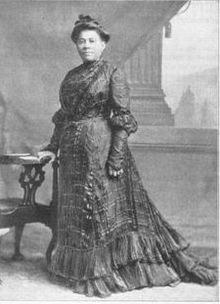Mary Talbert (Mary Burnett Talbert)

Mary Talbert was born in Oberlin, Ohio in 1866. As the only African-American woman in her graduating class from Oberlin College in 1886, Burnett received a Bachelor of Arts degree, then called an S.P. degree. She entered the field of education, first as a teacher in 1886 at Bethel University in Little Rock and then becoming assistant principal of the Union High School in Little Rock, Arkansas in 1887, the highest position held by an African-American woman in the state. In 1891 she married William H. Talbert, moved to Buffalo, New York, and joined Buffalo’s historic Michigan Avenue Baptist Church. Mary Talbert earned a higher education degree at a time when a college education was controversial for European-American women and extremely rare for African-American women. When women’s organizations were segregated by race, Talbert was an early advocate of women of all colors working together to advance their cause, and reminded white feminists of their obligations towards their less privileged sisters of color. Described by her peers as “the best-known colored woman in the United States,” Talbert used her education and prodigious energies to improve the status of Black people at home and abroad. In addition to her anti-lynching and anti-racism work, Talbert supported women’s suffrage. In 1915 she spoke at the “Votes for Women: A Symposium by Leading Thinkers of Colored Women” in Washington, D.C. During her national and international lecture tours, Talbert educated audiences about oppressive conditions in African-American communities and the need for legislation to address these conditions. She was instrumental in gaining a voice for African-American women in international women’s organizations of her time.
As a founder of the Niagara Movement, Mary Talbert helped to launch organized civil rights activism in America. The Niagara Movement was radical enough in its brief life to both spawn and absorb controversy within the Black community, preparing the way for its successor, the National Association for the Advancement of Colored People (NAACP). Central to the efforts of both organizations, Mary Talbert helped set the stage for the civil rights gains of the 1950s and 1960s. Talbert’s long leadership of women’s clubs helped to develop black female organizations and leaders in communities around New York and the United States. Women’s clubs provided a forum for African-American women’s voices at a time when they had restricted opportunities in public and civic life. In both Black and white communities, women’s clubs fostered female leadership. As a historic preservation pioneer, Talbert saved the Frederick Douglass home in Anacostia, D.C. after other efforts had failed. Buffalo’s 150-year-old Michigan Avenue Baptist Church, to which the Talbert family belonged, has been named to the United States National Register of Historic Places. Many prominent African Americans worshipped or spoke there. The church also had a landmark role in abolitionist activities. In 1998, a marker honoring Talbert, who served as the church’s treasurer, was installed in front of the Church by the New York State Governor’s Commission Honoring the Achievements of Women.
In October 2005, Mary Talbert was inducted into the National Women’s Hall of Fame in Seneca Falls, New York. She is also remembered around the United States as the namesake of clubs and buildings. Mary Talbert died on October 15, 1923 and is buried in Forest Lawn Cemetery (Buffalo). A small collection of Talbert family papers survives in the Research Library of the Buffalo History Museum.
Born
- September, 17, 1866
- USA
- Oberlin, Ohio
Died
- October, 15, 1923
- USA
- Buffalo, New York
Cemetery
- Forest Lawn Cemetery
- Buffalo, New York
- USA



